It’s no secret that aquatic plants need carefully regulated amounts of Carbon Dioxide to thrive.

Though a dual-stage valve that reduces pressure is an advantage in such setups, it’s not a necessity for the best CO2 regulator your aquarium could use.
I will explain the importance of a number of components that make up this piece of equipment.
For instance, what’s a needle valve, and what role does it play in the whole CO2 system? Is your choice of CO2 regulator tied to the size of your aquarium? What will suit a nano tank with aquatic plants and also the opposite – larger setups?
Obviously, your budget can also come into play when you buy, so is getting a unit that falls on the cheap side of pricing worth it?
You’ll also need to look for a timer that binds the release of Carbon Dioxide to the set photoperiod because that’s when plants utilize the compound. Following these thoughts, it’s obviously best if CO2 regulators have a solenoid valve which is a vital component when looking after high-tech planted aquariums.
Let’s take a look at the best CO2 regulators that will help you build a stunning planted aquarium.
Overview of the Top 5 Aquarium CO2 Regulators
Before we start, here’s a quick overview of the top CO2 regulators:
| Regulator name: | Decompression relief: | Price bracket: |
|---|---|---|
| 1. Fzone PRO Dual Stage CO2 Regulator | Dual Stage | $$$ |
| 2. Fzone Aquarium Dual Gauge | Single stage | $ |
| 3. DoubleSun Double-gauge | Single stage | $ |
| 4. FZONE Dual Stage Mini | Dual stage | $$ |
| 5. MagTool Dual Stage | Dual stage | $$$ |
A Beginner’s A-to-Z guide on CO2 regulators and their role in home aquariums

Due to competition, different companies usually design the same product differently, coming up with new features or improving on old ones to have an edge.
It is the same case when it comes to CO2 regulators; they come in different shapes, sizes, and with varying features.
It is up to you to decide what is optimal for your setup, but I will try to provide some helpful pointers.
Here is a complete beginner’s guide to help you choose an appropriate CO2 regulator for your aquarium:
1. With or Without a Solenoid Valve
Aquarium plants need CO2 but only during the process of photosynthesis.
Photosynthesis occurs only in the presence of light, so if the light is off, much of the CO2 you inject into your aquarium goes to waste.
Here’s what a solenoid valve does in conjunction with an aquarium CO2 regulator:
A solenoid is a device that allows for control over the CO2 consumption in an aquarium while making the process incredibly efficient. A solenoid works with a timer that is connected to the aquarium lights. This way, when the lights go off the solenoid valve turns off the CO2 supply automatically.
If your CO2 regulator is without a solenoid, you always have to be physically available to turn off the CO2 regulator.
A solenoid valve is, in my opinion, a crucial part of a CO2 regulator that operates in a planted tank.
2. Needle Valves and how they impact the even delivery of Carbon Dioxide
Here’s what’s a needle valve and what role it plays in your aquarium CO2 regulator:
A needle valve is responsible for delivering the CO2 in the aquarium at an even pace. With one, you’ll be able to fine-tune the gaseous Carbon Dioxide release so that it doesn’t storm the fish tank and cause harm to its live inhabitants. The needle valve achieves this by further normalizing the pressure from the cylinder in accordance with the desired flow rate of the CO2 bubbles.
Without such a valve, the CO2 may get violently pumped into the tank when the cylinder is near-empty.
This is so because, when close to running out of CO2, the cylinder cannot maintain a high pressure inside.
Because of the difference in pressure, a regulator without a needle valve will compensate by sucking out all of the remaining CO2 in the cylinder and dumping it into the aquarium all at once. In such doses, CO2 can be fatal for the fish or shrimp inside the planted tank.
This phenomenon is also affected by the stage of pressurization control.
3. Single Stage Vs Dual Stage Pressure Relief
As the liquified Carbon Dioxide in the cylinder decreases, the CO2 regulator’s delivery pressure tends to increase because the remaining bit is mostly in gaseous form. Gaseous CO2 exerts lower opposing pressure.
This can at times cause enough imbalance, leading to the “end of the CO2 tank dump” phenomenon.
So here is the role of dual or two-stage pressure relief in an aquarium CO2 regulator:
A dual-stage valve ensures that the output pressure from the CO2 cylinder remains constant as its content flows into the aquarium, even when the Carbon Dioxide is in a gaseous state. A CO2 regulator with a double stage valve reduces the pressure twice, providing more precise control over the dump of Carbon Dioxide in the aquarium.
In that regard, a single-stage CO2 regulator is not unreliable but will need more diligent supervision towards the end of the CO2 cylinder.
Author’s note: If the pressure inside the bottle starts dropping and you have a single-stage regulator you’d want to refill the cylinder before it runs completely empty.
But how is this achieved and how exactly does a double-stage pressure relief work?
The pressure reduction in the CO2 regulator is realized in two stages.
Both stages comprise a diaphragm, spring control valve.
In the first stage, the pressure is decompressed to around three times lower than the pressure in the CO2 tank.
Then the pressure is further lowered in the second stage to a range you can easily control with the adjustment knobs.
On the other hand, a single-stage regulator tends to lose some control when the pressure gets higher as the cylinder nears depletion. In that case, more frequent adjustments are needed when the tank is near-empty.
If you are using a single-stage pressure relief, you need to be around to adjust the flow rate whenever necessary.
This is not as annoying and time-consuming as it sounds, because it won’t happen often.
Additionally, a single-stage CO2 regulator is safer and more reliable compared to a double-stage model.
I should also point out that the single-stage regulator beats the dual one on the price.
It should be pointed out that the EOTD (“end of tank dump”) is not something bound to occur whenever the CO2 cylinder is near-empty. This may or may not happen and actual reports of it are somewhat rare among users of pressurized CO2 systems with a single-stage regulator.
It should be also noted that the most common choice of a CO2 regulator among beginner fishkeepers is a single-stage one.
That’s so because you can easily prevent EOTD events by monitoring the gauges on your regulator.
When the tank is full of liquid CO2 its internal pressure will be somewhere between 800 and 850 PSI.
When the pressure gets considerably lower than that (read, around 750 to 700) it’s time for a tank refill or replacement.
EOTD supposedly happens when the internal pressure has already dropped to around 500 PSI.
4. Easy-To-Read And Accurate Gauges
Obviously, some devices are not made for a layman, and the same can be said for the Carbon Dioxide regulators.
It’s not rocket science per se, but it can get confusing if you’re a beginner.
Fortunately, there are CO2 regulators with easy-to-understand gauges.
Here is what to consider when it comes to readability and accuracy while choosing a Carbon Dioxide regulator:
Go for a CO2 regulator you can always read and understand fast enough at a glance.
If you have to think to figure out what is what, then the model you’re looking up is probably not for you.
Readability is so important with these devices because the person operating them should be able to understand the CO2 regulators and react in time when needed to avoid fish fatalities.
Also, if you have problems reading tiny fonts, make sure to get a CO2 regulator with a font large enough for you to see clearly.
5. Durability & Build Quality
Basically, CO2 regulators are made to last but, as I have said, there are those competitive manufacturers who go the extra mile to design models that have tremendous durability.
Here are the materials that the most durable CO2 regulator are made of:
If a CO2 regulator is made of brass, aluminum, aluminum alloy, stainless steel, or steel alloy, it can be a good sign that it is durable.
Know that more sturdy builds will come at a higher price, because of the materials used.
6. Pricing
At times, we all need to filter products based on their prices. After all, you only buy what you can afford.
Here is what to consider as you decide how much you want to spend on a CO2 regulator:
Take time to balance the price against the pros of a CO2 regulator. A cheaper CO2 regulator may come with limited features or less durable materials.
That being said, the ones I’ve included below do have a decent amount of positive feedback and I’ve also tried a couple of them personally.
I made sure to only list ones that will serve you well, but that’s upon proper usage.
The products in this category are rather sensitive and improper usage can lead to malfunctions quickly.
A lower price does not necessarily reflect a build that won’t last, but rather how human-error-proof the device may be.
If you use your unit with care, you’ll be able to provide it with a long life despite, say, the lower pricing.
7. Compatibility
While there is no single CO2 regulator that fits all CO2 cylinders, there are particular ones that agree with many.
Here is the obligatory reminder about a CO2 regulator’s compatibility with gas cylinders:
If you have many different types of CO2 cylinders that you’ll be interchanging, you should go for a CO2 regulator that is compatible with them. If you have only one CO2 gas cylinder, make sure the regulator you buy agrees with it.
The Best CO2 Regulators For A Stable Planted Aquarium: My Top 5 Recommendations
To find the best type of CO2 regulator for your particular aquarium you’ll need to consider the advantages of a model and compare it to your personal preferences and goals.
The CO2 regulators that I’ve reviewed here have either proven themselves to me personally or someone I know in real life.
I consider all of them to be worth their price tag.
These are the best CO2 regulators for a thriving planted aquarium:
1. Fzone PRO Series DUAL STAGE – The Best CO2 Regulator for Beginners
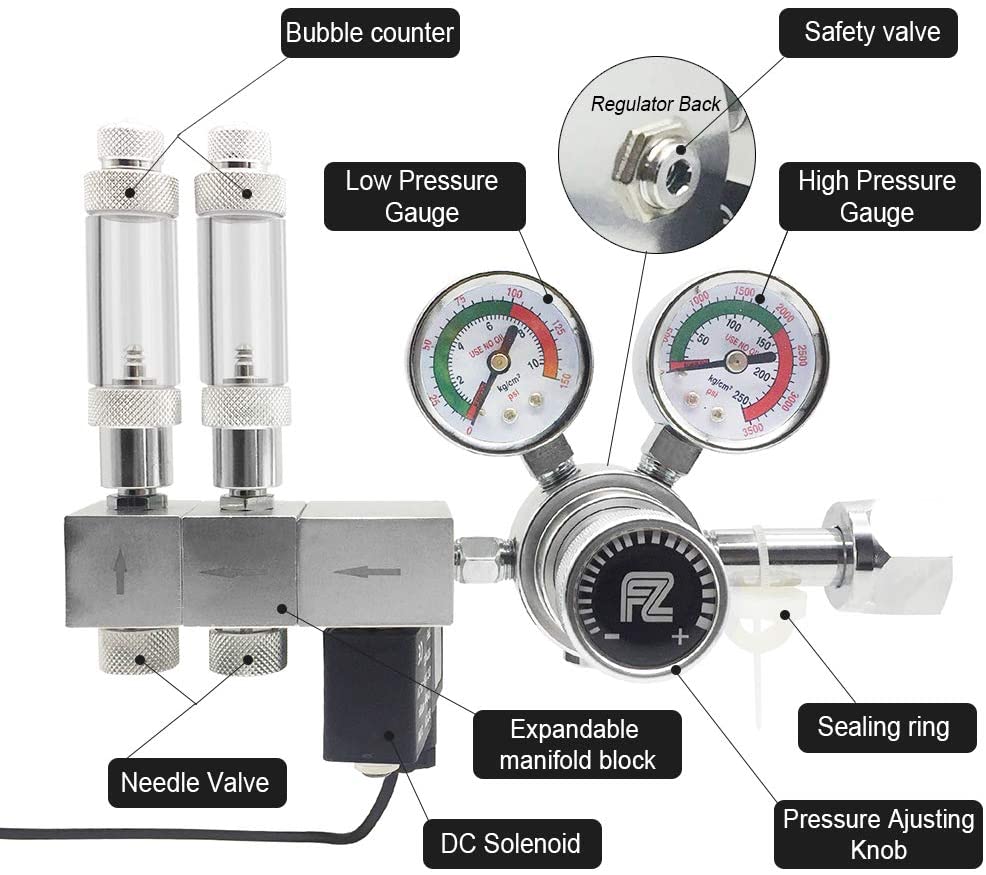
Click here to see the current price + more photos on Amazon.
I’ll list a few more Fzone CO2 regulators in this article, but the Fzone PRO Series is what I consider their best product overall. The Fzone PRO CO2 regulator has many advantages over the others and feels like an expensive brand name while coming at a very reasonable price.
The first thing you’ll notice is that the PRO Series has two stages of pressure relief, which is exceptional for this price tag. Dual-stage CO2 regulators usually start at 200 bucks or more and are not something everyone can afford.
Anyway, with its dual-stage of pressure relief, the Fzone PRO makes sure that you don’t have to worry about an End of Tank Dump event.
You won’t have to constantly monitor the internal pressure of your CO2 tank and wonder whether it’s time to refill or not.
Another fantastic feature of this CO2 regulator is that it comes with 2 needle valves and bubble counters.
Each needle valve and bubble counter are on a separate manifold block, and more manifold blocks can be added to the system if you run more than one tank.
This means that, out of the box, this CO2 regulator can supply two separate planted aquariums but you can get more manifold blocks and increase that number to as many as you’d like.
This is an excellent feature for people like me who want to, or already have, multiple planted tanks at home.
Anyhow, it’s time to discuss the needle valve and bubble counter on their own. I have to say, the needle valve is very user-friendly. This is so because it is neither too sensitive, nor too insensitive to adjustments.
It was pretty easy for me to nail the precise flow of Carbon Dioxide bubbles that I desired for my planted tank(s).
This is something that most aquarium CO2 regulators have an issue with, but not the Fzone PRO Series. The bubble count stays where I want it all the time and there are no additional adjustments.
Anyhow, another advantage this CO2 regulator has is that its DC solenoid valve does not get hot to the touch. The solenoid is also very quiet, which, to me, was important too.
When researching this CO2 regulator, I rarely came across reports where the solenoid valve failed. However, they were too few to consider this a design flaw rather than human error.
Nevertheless, should the solenoid of this CO2 regulator fail, it’s a regular 12V one and not a 120V one. This means that it’s very easy to find a replacement and also, it’s safer to use around the aquarium.
Another cool thing this CO2 regulator has is a built-in safety valve that will automatically turn on when the pressure exceeds 100 PSI.
This is, in my experience, more than welcome because it’s one less thing to worry about.
Anyway, now comes the obvious question:
With all of these features and the lower price, did the manufacturers compromise with the quality of the build?
Honestly, I would say no.
The Fzone PRO feels like a high-end Dual Stage CO2 regulator and is made of what appears to be high-quality aluminum.
There’s nothing plastic in it and it feels very durable. Mine has been running without issues and I suspect it will be so for years to come.
Anyhow, the final thing that made me list the Fzone PRO as the best CO2 regulator for a planted aquarium, was the easy installation.
The instructions are very beginner-friendly and anyone who can read will be able to put it together themselves.
The pack comes with its Allen key included and you don’t have to worry about installation tools.
Overall, given the price and the included features of the Fzone Pro Series, I’d say that it is probably the best dual-stage CO2 regulator you could get for your planted aquarium.
It honestly has no competition.
Advantages:- Dual Stage (no chance of End of Tank Dump disasters).
- Fantastic price.
- Beginner-friendly installation and operation.
- Can supply CO2 to more than one planted tank at a time.
- The needle valve is very precise and is easy to regulate.
- 12V DC Solenoid that works silently and does not get hot.
- Automatic safety valve.
- Included Allen key in the pack.
- Appears to be durable and is made of solid aluminum.
- None as far as I’m aware
2. Fzone Aquarium Co2 Regulator Big Dual Gauge – Surprisingly Fair Priced

Click here to see the current price + more photos on Amazon.
The FZONE Big Double Gauge is one of the best performers in the field of CO2 regulators given its price tag and you should definitely consider it for your aquarium.
While comparatively cheap, this unit has all the necessary kits you should require of your future CO2 regulator.
First, it has a solenoid valve (110v) which operates flawlessly once you have set it to a timer.
If you want an automatic overnight shutoff, you just program it and the solenoid valve does the rest.
The solenoid runs noiselessly though you may hear a humming sound if you over-tune your ears.
The Fzone Aquarium Co2 Regulator Big Dual Gauge also comes with a wrench you are to use to tighten the unit to the tank, which is pretty handy.
Another thing you will see in the package is the check valve to stop water in the bubble counter from draining into the CO2 cylinder.
In terms of looks, this aquarium CO2 regulator has a decent appearance (I like the smooth touch of the knobs) and is made of high-quality aluminum alloy.
If used properly it should last you a decent amount of time, though it will not be the most durable unit on this list.
It is also easy to set up if you’re a beginner in the field.
Anyway, initially, the needle valve could be over-precise, and therefore slightly hard to control.
This should not worry you that much.
In my experience, you should just relax your fingers and adjust slightly by and by.
It’ll gradually pick up and behave.
You can set the customary two to three bubbles per second which in my book means it’s precise enough.
Anyway, though it was easy to set it up, I feel that this CO2 regulator should come with an instruction manual.
It’s a single-stage model, but if you pay attention to when the pressure in the bottle drops and refill it in time you will not have any issues.
Get this CO2 regulator if you’d like to get the best bang for your buck, while not breaking the bank for your new high-tech, planted tank.
Advantages:- Several kits are in the package – a solenoid, a bubble counter and a check valve.
- The price is more than fair.
- The components are made of aluminum alloy.
- The big dual gauge ensures you can easily read the pressure in the cylinder and the output pressure, which somewhat compensates for the single-stage pressure control.
- It comes without instructions, though if you email the company they promptly send it.
- Single stage (not really a problem, because the gauges are easy to read and you can be certain when it’s time to refill your CO2 bottle)
3. DoubleSun Double-gauge Aquarium CO2 Regulator – Comes with everything you need
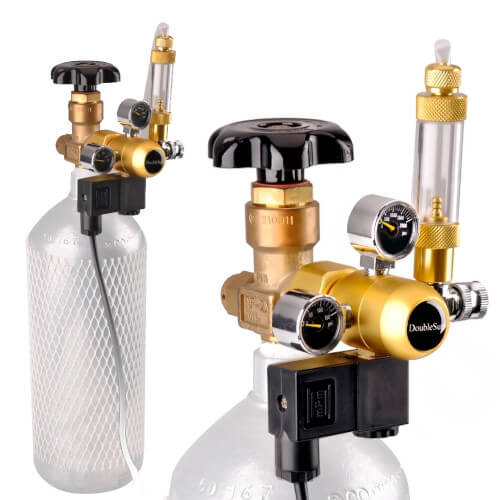
Click here to see the current price + more photos on Amazon.
If you are on a budget and are interested in a cheaper option, it may serve your aquarium’s interests best if you choose this double-gauge CO2 regulator.
But cheaper should by no means insinuate that it is a substandard version of a quality CO2 regulator.
The DoubleSun injects CO2 as precisely as any other suitable model.
The bubble counter and the nut holding the regulator are made from plastic and not glass as is customary, but in my experience, it’s no big deal.
Anyway, I have some thoughts on the solenoid valve.
The solenoid’s temperature remains stable at pretty much all times.
The hotness is usual, nothing to be concerned about.
Actually, for me, I’d describe it as warm and not hot, if that means anything to you.
Some users do complain that the solenoid makes a nagging humming sound.
In my experience with this CO2 regulator, it’s true that the solenoid can be noisy, but only under certain circumstances.
In any case, I would not describe the sound as potentially irritating, but you will notice it if it’s the only thing running in your planted tank’s room.
However, from what I have learned while using the DoubleSun CO2 regulator, this only happens if you over-tighten it.
It is somewhat confirmed by other reviewers online.
The only real noise I agree it makes is when you turn it on or off.
Otherwise, the solenoid reliably turns on and off as per the schedule if on a timer.
By the way, if you find the noise bothersome, you can use plumbing tape to get rid of it (not a troublesome “upgrade”).
One drawback of this CO2 regulator is that the water in the bubble counter drains after some weeks so you have to refill it.
The DoubleSun CO2 regulator has just one stage of pressure relief, which can be expected at this price point. However, I wouldn’t say that you should wait to accumulate a higher budget and save up for a dual-stage one.
The DoubleSun works perfectly fine and I’m very pleased with what I got for my money.
Buy this CO2 regulator if you don’t have deep pockets at the moment, and you’re okay with occasionally checking the pressure of the cylinder.
It’s an adequate purchase for a high-tech planted aquarium on a budget.
Advantages:- It is very affordable.
- Easy to install.
- It comes with a wrench and other essential installation tools.
- Being compact, it takes up little space.
- The noise during turning on or off may irritate or startle you if you are not used to such.
- You have to refill the bubble counter after some weeks.
- The bubble counter valve is rather over-sensitive, and it may take you time to tune it (once you get it right, it works well)
4. FZONE Aquarium CO2 Regulator Mini Dual Stage – The design makes for safe and steady CO2 injections
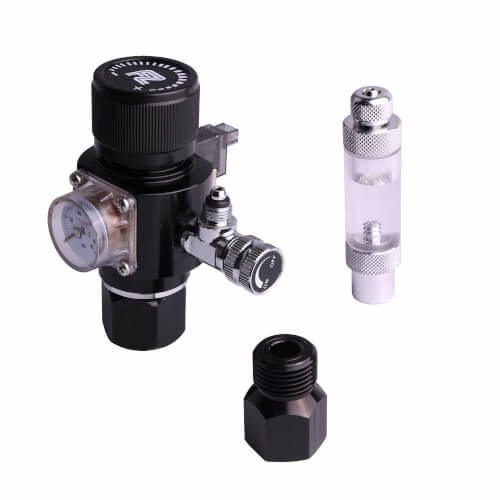
Click here to see the current price + more photos on Amazon.
First, I like The Dual Stage FZONE Aquarium CO2 Regulator Mini’s design and black color.
It’s simply nice and adds up to the cyberpunk look of your high-tech, planted aquarium.
It is made of aluminum alloy and is sturdy and heavy enough, as far as quality goes.
It is one of the best multi-stage CO2 regulators on the cheap side that I know of.
Due to its dual-stage design, this CO2 regulator is well-composed enough to withstand turbo-charge pressure without breaking or releasing excess CO2 if things get out of control.
Its strength makes it suitable for smaller nano tanks with demanding aquarium plants.
The FZONE Dual Stage CO2 Regulator Mini comes with an instruction manual to ease the work of setting up and further use.
The package includes all the necessary tools and kits as well.
This comprises 3 different wrenches (I simply call them spanners here at home).
This will save you from having to look for just the right fit elsewhere.
There are also spare O-rings with extra rubber.
Anyhow, if you went the DIY paintball cylinder road, worry not, for this aquarium CO2 regulator also comes with a paintball adapter.
This makes it compatible with several cylinder models, from disposable CO2 cartridges to 20 oz tanks.
There is also the solenoid, which remains cool even after running for hours.
The solenoid valve will shut off or turn on the moment the timer alerts it.
One of the best features of this unit is its needle valve which is considerably accurate.
The fine-tuning is a breeze, in my opinion.
The bubble counter is here too, and you can easily set it to count 3 or 5 bubbles per second.
You can read the pressure gauge without straining your eyes because it’s made clear, which I also like.
You are also probably going to love the fine-tuning pressure knob of the regulator.
With it, you can effortlessly set the output pressure anywhere from 0 to 60 PSI (pounds per square inch).
The surprise is that although this regulator has so much to offer, it remains relatively cheaper even compared to its dual-stage competitors.
Many suchlike models can cost way more.
Get this regulator for your aquarium’s pressurized CO2 system if you’d like to eliminate any possibility of the “end of tank dump” phenomenon while keeping within a reasonable budget.
Advantages:- Dual stage pressure relief
- Quality needle valve for the price
- Very budget friendly
- It can be used for vertical or horizontal tanks because it rotates.
- It comes with an easy-to-understand instruction manual.
- It is made from durable materials.
- It has all the components you would need for a CO2 regulator.
- It consumes less power compared to other models of its class.
- The pressure gauge is easy to read.
- At times, the bubble counter may leak, based on verified reports from some of my friends.
- Has some negative feedback on Amazon, but that’s mainly because of poor handling of the delivery (not the product’s fault, and you can always return it and either get refunded or demand for a replacement)

Click here to see the current price + more photos on Amazon.
The MagTool CO2 regulator is something I tried when I decided to update my knowledge about these tools some time ago.
I’ve been patiently waiting for a couple of months before updating this article with my full review of it.
So firstly, the MagTool is a dual-stage CO2 regulator which, along with the FZONE PRO Series, makes it something of an exception at its price bracket.
It eventually proved itself as a reliable regulator as I’m yet to see any form of pressure issues with it.
When I first unpacked my new MagTool it immediately striked me as a sturdy build.
Its construction felt stable in my hands and the overall look felt like something pulled out of a new age steampunk movie.
So after I got convinced the MagTool would look super cool on my tank it was time to assemble the thing.
I’d say the assembly was nothing out of the ordinary, I got through it confidently and without issues.
I was about to use it on a single planted tank so I did not include the second block of the modular manifold system. Same as with the FZONE PRO, the MagTool CO2 regulator can supply two tanks at the same time. Each manifold block has its own needle valve and will release gas independently, if used like that.
So after I’ve had it work for me for a while I got a better impression of its peculiarities. Pressure always seemed stable. My gauges were always indicating and everything seemed smooth.
In a moot attempt to roast this CO2 regulator not to appear too biased, I will say that the adjustment needle needs careful tuning.
Mine was somewhat sensitive.
However, my roast attempt ends here, because the dial is very comfortable on the hand and once the needle is adjusted it remains stable.
Finally, I have to mention MagTool’s customer support. I never ended up contacting them, but while researching this CO2 regulator I found blasting reviews about it form other users.
As far as I understand, they do go above and beyond to assist you with any issues you may have with their product.
This kind of helps me sleep better at night, knowing they got me covered.
So all in all, the MagTool Dual-Stage CO2 regulator is a good alternative to the FZONE PRO Series, as for this price range they stand undisputed.
You’d want to get the MagTool if you’re serious about your planted tank and eventually plan to get a second one.
Advantages:- Dual stage, pressure remains stable at all times
- Sturdy, solid build
- Has a professional look to it, adds to a tank’s aesthetics
- Easy installation
- Needle valve dial feels comfortable in the hand
- Adjustable pressure
- Modular blocks, possible to supply two planted tanks at once
- 12 V Solenoid, doesn’t get too hot
- Great bang for your bucks
- Safety valve
- The needle valve is sliiightly more sensitive than I’d like it to be but that’s not something that would stop me from getting this unit
Is Paying Less For A Cheap CO2 Regulator Worth It?
There is this deep-seated notion lurking in a buyer’s mind that if the product is cheap, it means it is substandard, not genuine, not capable enough, is faulty, and so forth…
All I can say is that it depends on what product you are buying.
There are indeed times when cheap turns out to be more expensive in the long run.
Here is the fact about cheap aquarium CO2 regulators:
Different models of aquarium CO2 regulators tend to be the same in terms of essential functionalities whether the price is cheap or expensive.
There is not much difference between costly ones and inexpensive ones when it comes to serving their purpose.
However, the expensive ones usually have additional features to make the work easier and are also made of high-quality, more durable parts.
If you feel you need to benefit from these extras, then paying a higher price will be perfectly justified.
The cheaper CO2 regulators will still perform effectively upon proper maintenance but the advanced ones are more efficient and will come with a warranty and extended durability.
See which durable, fish-safe paints you can safely use inside aquariums by exploring this guide.
Tips To Boost the Growth in Your Planted Tank Further
Well-programmed CO2 injections are not necessary for a planted aquarium, however, definitely speed up the growth processes of aquatic plants and give the benefit of more vivid coloration.
If you wish to see your aquarium plants look healthy and happy in a high-tech setup you will want to have a CO2 system set in place.
Carpeting plants like the Dwarf Hairgrass will grow denser and have a lush green color. The more non-demanding plants like Java Ferns will also grow better and benefit from CO2 injections.
Only the floating aquarium plants won’t really benefit from a CO2 injection system, because they already have access to the tank’s surface.
Anyway, Carbon Dioxide supply is just part of the strategy.
Just as you cannot thrive on oxygen alone, no matter how important it is, you can’t expect the plants to progress well solely on regular CO2 supply.
So here are some other tips to help you improve the plant growth in a planted aquarium:
- Ensure the plants have adequate lighting. After all, they only utilize the CO2 alongside light. The two virtually go hand in hand. Your choice of aquarium lighting should provide the correct light spectrum for plant growth alongside adequate intensity and water penetration of the beam. I have a very detailed guide on the best planted tank LED fixtures that fall within these criteria to help with making sure that your aquarium plants will thrive.
- Supply essential nutrient elements to the plants via fertilizers. In a closed environment such as a home fish tank you simply can’t provide all the building blocks that lush plants would require to grow in a high-tech setup. You’ll need to understand macro and micronutrients and also recognize which of these (if not both) do aquarium plants need. I can help you choose the best aquarium plant fertilizer for your setup. Visit the link to go in-depth on that.
- Lay a suitable substrate for anchorage and additional fertilization. This is pretty much self-explanatory, as it functions similarly to land-based vegetation. However, if you don’t know the difference between an inert and a soil substrate I recommend that you pay a visit to my guide on planted tank soils and substrates. There you’ll learn how to combine these for better aesthetic and plant growth, how to spot false advertising, and which will work best for your future high-tech setup.
FAQs
What is the easiest one to use for beginners with a planted aquarium?
The best CO2 regulator for a beginner would be one that has the most safety nets installed in the model. These are typically the Dual-Stage ones. Alternatively, a beginner should look for a CO2 regulator with needle valve that easy to adjust. As a beginner, you’d want to avoid the needle valves that are overly-sensitive.
What is the best CO2 level for a planted aquarium to thrive?
CO2 in the aquarium becomes toxic to fish at levels of around 30 ppm. Keeping the CO2 levels in your planted aquarium below that is the ideal compromise – juest enough to boost the growth of aquatic plants while keeping your fish alive.
It’s important to remember that the amount of CO2 your aquatic plants use up is tied to the intensity of your aquarium lighting. If your aquarium lighting is not strong you should maybe keep the CO2 levels in the tank at around 15 ppm.
Can too much Carbon Dioxide hurt the fish in my planted aquarium?
Yes. You should not ramp up the CO2 levels in your fish tank above 30 ppm. At this level the CO2 may start to suffocate your fish.
Is this the best way to add CO2 to an aquarium?
Dedicated CO2 regulators are the best way to add Carbon Dioxide to a planted tank. The cheaper Aerosol CO2 sets do not allow for as much control over the process. Control is very important if you want optimal results while keeping your fish and plants safe.
My Conclusion
Choosing the right equipment will save you tons of anxiety for the lives of your aquatic plants and fish.
Also, remember that a solenoid valve is a must-have if you want the regulation to time itself as you mind your own business.
Ideally, look for the dual stage regulator and pick that if your budget allows it.
At the end of the day, you want to see your planted aquarium flourish and one of the best ways to achieve that is by engaging a suitable CO2 regulator.
I’d like to believe that this article has, to whichever extent, boosted your technological knowledge on the subject.
Drop me a comment below if you have any questions or can’t decide on a piece of equipment.


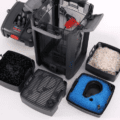
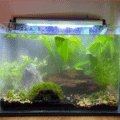




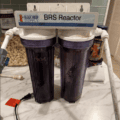
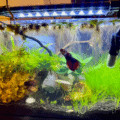

Great article! I already learned what to look for when shopping around for the best co2 regulator for planted tanks. Thanks for writing this post!
Thanks, appreciate it.
Momchil
Fzone PRO just went unavailable on Amazon! Wondering if you’d be able to find it somewhere else for us
Hi Max,
They usually restock soon enough, just give them a couple of days.
FZONE’s Pro Series Aquarium CO2 Regulator is a pretty new piece of equipment that turned out to produce a lot of demand (for obvious reasons). I’m sure FZONE are doing their best to restock as soon as possible.
In fact, I actually ended up contacting them and asking them when they plan to restock. EDIT: They replied in just under 10 minutes and assured me that the CO2 Regulators will be restocked in 5 to 10 days! Amazing support!
Anyway, Amazon usually has the best price for this product. You could likely find it on AliExpress for cheaper, but it may take months before the arrival. eBay also has these CO2 regulators, but the prices there are not competitive at all.
-Momchil
Hello,
I am wondering what you’d estimate the annual cost of CO2 upkeep to be (cost of CO2 tanks). I am planning for my 10 gallon tank to have a Dwarf Hairgrass carpet, and while I know CO2 is not mandatory for this plant, I want the carpet to be as lush as possible! I am also wondering if liquid CO2 supplements are a feasible alternative, or if you’d advise against this. I love your website, thanks so much!
Hi Jackie,
I’m super glad you like my blog!
Anyway, the initial set-up cost of a CO2 injection system can be anywhere between $180 and $300, depending on the class of the components. From then on you only have CO2 refills which cost no more than 5 to 10 dollars per refill.
Getting CO2 for your carpeting aquarium plants will always yield better results, there’s no doubt.
So, liquid CO2 releases way less Carbon than a CO2 injection system. These chemicals are usually algaecides that “eat” a film of organics that builds up on your plants. Without this layer, the aquatic plant can better absorb the CO2 in the water and grows faster and larger. However, a downside is that these liquid CO2 supplements may be harmful to the more fragile fish in the aquarium.
All in all, with a CO2 injection you’ll get better growth and I’d always recommend that over liquid CO2.
Did this answer all of your questions? Feel free to reach out whenever.
Happy planted tank keeping! 🙂
Thank you. I’ve had aquariums since 8 yrs old and 62 now. I am presently turning a 55 into planted for my Angel fish. You have helped my understanding greatly.
Hi Robert,
Thank you for being a reader! Helping people like you makes me extremely happy!
Good luck with the planted tank!